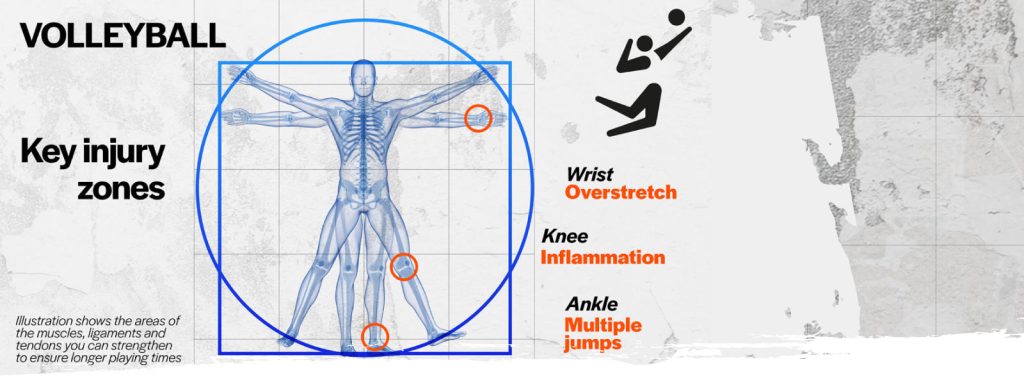Volleyball was born on the East coast as a contact-free, lower intensity alternative to the newly rising US sport basketball. American soldiers spread it to Europe during WW1. The most well-known variation is beach volleyball, which originated in Hawaii about two decades after the original game. It found a lot of success during the 1930s as a very inexpensive yet fun game to play.
Volleyball is arguably less intense than other team sports, but it still requires remarkable athleticism. Volleyball players are the closest a human can get to a feline: ready to pounce when necessary, with incredible speed and power, and with incredible reflexes too*.
Generating that power though, comes with some risks. Volleyball is not injury free, but the good news is that most of them come from overuse of a specific muscle group/joint. They are therefore preventable. Indoor volleyball and beach volleyball present a very similar injury profile, and can therefore be analysed together**.
First of all, let’s have a look at what the most common affected areas are
Ankle
Similarly to basketball, the amount of jumping and the amazing height of each jump contribute to the deterioration of ankle health***. The “problem” is not that your ankle is not made for this movement, but rather that among the hundreds of them there will certainly be few (statistically) that are not optimal, a little squint, a little forward, etc. Now multiply this over the amount of training sessions and you have a lot of potentially dangerous jumps!
Wrist
Your wrist is not a single joint. It is actually composed of 15 little bones connected with ligaments! When those multiple joints are subjected to sudden jerky moves outside a comfortable range of motion this delicate balance is disrupted, and some soreness/swelling may arise***. Once again, try not to think of that specific time you blocked, passed, or that wrong hand positioning in your dig etc. It is the sheer amount of times you did it… so it is not your fault, don’t worry!
Knee
There it is again…. The knee is a love/hate relationship in many, many sports. To simplify, you can imagine the knee as three bones: the long top one (femur), the long bottom one (tibia) and a round bony disc in front (patella, or kneecap). In between them we find tendons to bind them together, and softer pads to absorb shocks and friction. When you exert repeated force on your knee, those pads suffer, and become inflamed***. To prevent any further damage, our amazing body pours fluid around them, keeping them cool and lubricated (at the expenses of freedom of movement and with swelling thrown in). That is the signal that tells you to stop and rest for a while.
Let’s get ready to put some effort to prevent these injuries, and become an even better volleyball player!
EXERCISES
Ankle strengthening – 1
From standing, raise on your tiptoes as high as possible. Feet point forward first (neutral standing position) for 20 times, feet rotated inward for 20 times and then outward for 20 times. Repeat it all for 3 times.

Wrist strengthening
Hold one end of the resistance band in your hand and the other under your foot. Create the correct tension (mild) and pull the elastic using your wrist only. No arm movement allowed! Repeat 30 times each hand for 3 sets.

Knee stretching
Lie on your back, cross your legs so that one shin is over the other thigh, and pull the non-rotated leg as close to your chest as you can. Hold for 45 seconds, 4 times each leg.

References
*Reeser, J. C., Bahr, R. (2003) Handbook of sports medicine and science – Volleyball. 3rd Edn. Malden: Blackwell Scientific.
**Jimenez-Olmedo, J. M., Penichet-Tomas, A. (2015) ‘ Injuries and pathologies in beach volleyball players: a systematic review.’ Journal of human sport and exercise, 10(4), 936-948
***Baugh, C. M., Weintraub, G. S., Gregory, A. J., Djoko, A., Dompier, T. P., Kerr, Z. Y. (2018) ‘Descriptive epidemiology of injuries sustained in national collegiate athletic association men’s and women’s volleyball 2013-2014 to2014-2015’. SAGE – Sports Health, 10(1), 60-69
Further reading
Encyclopedia Britannica (2020) Volleyball [online.] https://www.britannica.com/sports/volleyball






